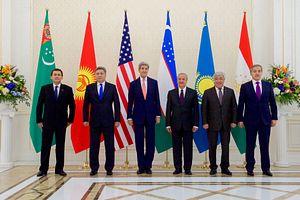Foreign ministers from the five Central Asian states converged on Washington, DC today for the second meeting of the C5+1, a diplomatic vehicle its members hope will help the region address common challenges. Last fall, when the grouping first gathered–in the ancient city of Samarkand–the ministers decided to focus their efforts on producing concrete results. The meeting, after brief public opening remarks, will continue today behind closed doors. A joint statement is expected at the close.
In a preview press call last week, Deputy Assistant Secretary for South and Central Asia Daniel Rosenblum said that the ministers had agreed last fall to focus on three specific areas. Rosenblum listed them like this:
First, the economy and specifically how to connect Central Asia economically to a broader region and to the U.S. That’s the first area. Secondly, the environment, with a special focus on how to deal with the impact of climate change. And third, security, with a special emphasis on the threat of terrorism and also the question of stability in Afghanistan.
U.S. Secretary of State John Kerry in his opening comments, however, inverted the order (as did most of the ministers speaking after him). Security and counterterrorism got first mention, followed by trade and investment, economic development, and climate change issues. This perhaps reflects the reality that the United States and Central Asian governments do not quite see eye-to-eye on the ordering of priorities. Kerry noted that the ministerial hoped to announce major steps, particularly with regard to several concrete projects addressing counterterrorism, economic competitiveness, transportation, and clean energy. The only specific detail mentioned by Kerry in the introduction was a $15 million U.S. commitment toward five projects in Central Asia.
As the Central Asian states’s 25th anniversaries of independence approach in the latter half of the year, many in Washington see little bilateral progress to celebrate. The United States’ initial efforts in the former Soviet space have been fumbling at best. Democratization initiatives have largely come to nothing but hardening authoritarianism and a by-product of the war in Afghanistan was the flattening of Washington’s dealings with Central Asia into a single dimension: security. Meanwhile, the region’s states remain more economically connected internationally–as recently exposed telecommunications corruption scandals demonstrate and the oil and gas business necessitates–than they are to either the United States or each other. (Yesterday, Casey Michel explored the crash in U.S.-Central Asia trade last year.)
The C5+1’s agenda–which prioritizes economic connectivity, environmental issues, and security–leaves out human rights as a priority. Although the C5+1’s joint declaration after their initial meeting last year reaffirmed the members’ commitment to protecting human rights and the development of democratic institutions, skeptics would point to Tajikistan’s crackdown on the opposition, Turkmenistan’s jailing of journalists, Kazakhstan’s prevention of peaceful demonstrations, Uzbekistan’s use of forced labor in the cotton harvest, repeatedly rigged elections in several regional states, and more as demonstrating the flimsy nature of such a statement. Rosenblum, in the preview call, noted that Washington would also address “the so-called human dimension” with the ministers.
The ministers, in their opening remarks stuck to boilerplate comments. Speaking first after Kerry, Turkmenistan’s Foreign Minister Raşit Meredow concentrated on multilateral cooperation and that stability was a priority. Abdulaziz Komilov, Uzbekistan’s foreign minister, said the C5+1 platform might be useful in discussing areas of mutual interest. Kyrgyz Foreign Minister Erlan Abdyldaev, said full-scale regional cooperation was a priority, with an emphasis on active dialogue. Kazakh Foreign Minister Erlan Idrisov encouraged the development of a “family spirit” in addressing common regional challenges. Speaking last, Foreign Minister Sirodjidin Aslov of Tajikistan listed the region’s challenges as including terrorism, extremism, radicalization, drug trafficking, and economic turbulence.
Washington–as the war in Afghanistan winds (ever slowly) down–is recalibrating the way it approaches the Central Asian region and likely views the C5+1 format as an investment in the long diplomatic game: betting that increased economic connectivity and transnational cooperation on climate change will contribute to better regional governance, stability, and recognition of human rights. As some of the ministers noted, Central Asia engages in similar format dialogues with the European Union and Japan, among others. The C5+1 format might give the United States and its Central Asian partners a more routine schedule of interaction but it’s yet to be seen if that will be fruitful or simply another calendar appointment.
One problem with the long game, as brought up by a Russian journalist in the preview call, is the uncertain continuity of this new endeavor given the pending U.S. presidential election. While the day-to-day of U.S. foreign policy is managed by career civil servants and continuity is typical, it’s not guaranteed that every initiative begun under the Obama administration will be continued, let alone one begun so late in a corner of the world very far removed from the United States.

































